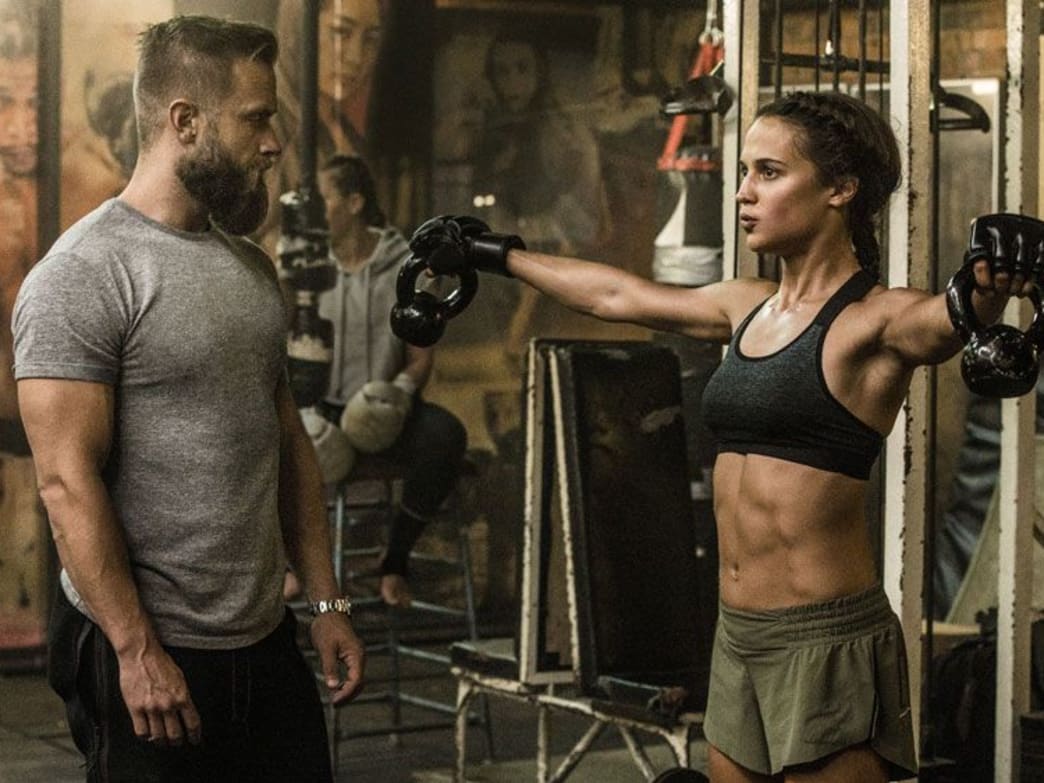
Magnus Lygdback, who trained Alicia Vikander for her role in Tomb Raider, explains how to get started in the gym.
When you’re new to the gym it’s very easy to stay in your comfort zone, hitting your cardio machine of choice for a bit then sliding right on out of there. There’s nothing wrong with a cardio workout, of course, but do the same thing over and over again you’re unlikely to experience any benefits and you’re likely to get hella bored – a surefire combo to start you skipping sessions and regret joining every time you see the direct debit go out.
To avoid that fate follow this simple workout plan from Magnus Lygdback, who trained Alicia Vikander ahead of her role as Lara Croft in Tomb Raider.
“If you’re new to the gym it’s important to build up the fundamentals,” says Lygdback. “Make sure you keep good form and don’t go too hard. But the philosophy remains the same for me whether you’re a beginner or more advanced. If you want to tone up and build some muscle mass I’m a big fan of a three-split programme. You work through your whole body in three days.”
How To Follow This Workout Plan
Lygdback’s plan involves doing three 45-60 minute sessions. Every workout starts with 15 minutes of high-intensity interval training (HIIT), before moving on to strength exercises that target different areas of the body for 30-45 minutes.
“HIIT is always a good idea, whether you’re a beginner or not,” says Lydgback. “I always start the first ten to 15 minutes of my session with some intervals. It could be on a treadmill, a rower or a bicycle. Warm up for five minutes, then do 60 seconds at your maximum capacity, then rest for 60 seconds. As a beginner I’d do that three to five times.”
The workouts should be done in the order listed below for best results, but you don’t have to do them on set days each week.
“I will let my life determine when I work out,” says Lygdback. “Personally I’m on a four-split programme and I just keep that rolling. Sometimes I rest on a Wednesday, sometimes I rest two days in a row on the weekend, and sometimes I work through the weekend. I listen to my body and let life dictate a little, because we all have a life outside of the gym!”
When it comes to the strength sections of the workouts it’s important to work the target areas from all angles, but Lygdback suggests it’s not vital to have an exact list of exercises to follow when you walk into the gym. Lygdback has suggested some exercises for each of the workouts but make sure you mix it up and target the muscles from different angles each time. You’ll find plenty of options on our exercise guide pages.
For each workout, Lygdback recommends five or six exercises, doing three sets of high numbers of reps – 20 for exercises where you alternate the main limbs involved, like lunges, and 15 for non-alternating exercises like front squats. For all exercises he recommends mastering the form first before worrying about how much weight you use.
“Form is number one,” says Lygdback. “Weight is secondary. Never push the weight and never compromise on good form.” If you’re unsure, ask one of the PTs at the gym – that’s what they’re there for.
Workout One: Legs And Core
After your 15 minutes of HIIT concentrate your session on the legs and core, making sure to hit all the major muscle groups in the legs as well as your glutes.
“A goblet squat is a very good exercise for beginners,” says Lygdback. “Hold a kettlebell or a dumbbell in front of your chest and then do a regular squat. The reason for the weight in front of your body is that you activate the core and the lower back, because you make those muscles fire before you squat.
“I’m also big fan of lunges, which work the back side of the legs, the hamstrings and glutes. And also skater jumps, which work your fast-twitch muscle fibres and activate the small glute muscle fibres as well. That’s a nice little combo anyone can do.”
RECOMMENDED: Leg Exercises | Core Exercises
Workout Two: Back, Shoulders And Core
“On day two I would say work your back, shoulders and core again, but maybe the obliques with more rotational movements instead of the inner core muscles,” says Lygdback.
“I would do one straight pull, like a lat pull-down. You can’t expect anyone to do a pull-up in the beginning. Then a rowing exercise. There are so many options, from a standing dumbbell row to a sitting row with a cable machine. Then something else for the back, to change the direction of pulling. Then for the fourth exercise some kind of reverse flye to activate the rhomboids and shoulders. Then work the outside shoulders with the fifth exercise, something like a lateral raise.”
RECOMMENDED: Back Exercises | Shoulder Exercises | Core Exercises
Workout Three: Chest And Arms
“After interval training move on to the chest, then the biceps and triceps,” says Lygdback.
“For the chest it could be press-ups, chest press or bench press – anything where you’re pushing. And then biceps curls and triceps press-downs. Just switch it up. The most important thing is to work the right muscles.”
RECOMMENDED: Chest Exercises | Arm Exercises | Biceps Exercises | Triceps Exercises
Written by Nick Harris-Fry for Coach and legally licensed through the Matcha publisher network. Please direct all licensing questions to legal@getmatcha.com.
Featured image provided by Coach

 Copyright © 2018 XR Nutrition.
Built with love in Utah
All rights reserved.
Copyright © 2018 XR Nutrition.
Built with love in Utah
All rights reserved.